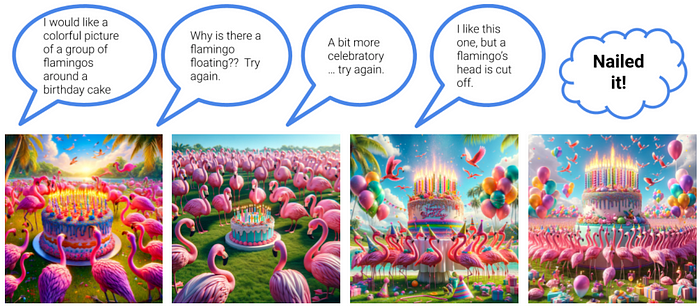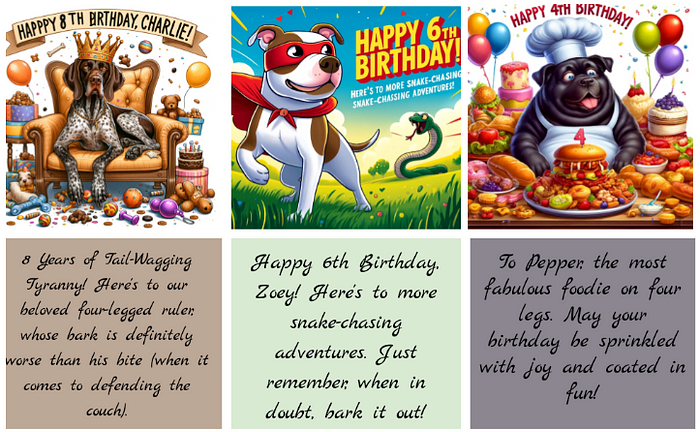
The Controversy of AI Greeting Cards
Last Updated on April 11, 2024 by Editorial Team
Author(s): GaryGeo
Originally published on Towards AI.
Today I am taking a slight detour from my usual data analysis, to indulge one of my favorite hobbies — crafting personalized greeting cards, now with a significant boost from Artificial Intelligence.
My fascination with creating unique holiday, anniversary, and birthday cards for my family has evolved from handwritten notes to stylized photos to graphic designs. Yet, my latest versions leveraging ChatGPT and DALL·E have been the most rewarding. Collaborating with AI, I’ve watched my ideas not only come to life but also transform in surprising ways.
But there is also a question in my house on who is really doing the making… me or the AI?
Crafty Cards with the Help of ChatGPT
The process is straightforward and incredibly fun. All it takes is a moment to reflect on the person, the occasion, and the message you wish to convey, and then you dive into the creative process.
For my wife’s recent birthday, inspired by her fondness for flamingos, I crafted a card that I hoped would echo her vibrancy.

After settling on the imagery, I sought a playful poem to accompany it. The exchange with ChatGPT was dynamic, filled with edits and new suggestions until we landed on a limerick that felt just right:
Flamingos are pink, hammocks are fun,
At forty-eight, you shine like the sun.
A wife and a mom, simply the best,
In every test, you’re above the rest.
Happy birthday, my love, you’re my number one!
With the image and poem in hand, the final step was assembly — best done manually, given the current limitations of AI in precise image manipulation. The outcome? A card that was creative, funny and personal to my wife.
The Controversy
After sharing the card with my wife, I wasn’t prepared for the controversy that erupted in my house over its creation. When I revealed that I had used AI to assist in creating the card, my oldest child challenged me, saying, “So you mean AI made it,” questioning the notion of my authorship.
This critique prompted me to reflect on the creative process. Indeed, AI played a significant role, but the card bore my style and my choices. This was surely better than a store-bought card, wasn’t it? I could have “made” the card using craft paper and a marker, but even those are tools. This led me to ponder: When does a tool strip all craftsmanship and creator credit from a creation?
I would argue that on one extreme, simply pulling a Happy Birthday card from a 10-pack in your desk drawer, writing “To Ann,” and signing your name clearly isn’t “making” a card. What if you wrote a couple of paragraphs? What if you went out of your way to Hallmark, spent an hour selecting a card, wrote a few paragraphs, and included some old photos? While I’m not sure you’ve “made” the card, you’ve made it special. On the other extreme, if you quickly jot down “Happy Birthday” on some craft paper and then sign your name, you have technically “made” the card, but it hasn’t been made special.
Perhaps the right way to think about this is in terms of how much “investment” you have in the creation. Whether it’s from the store, hand-illustrated, or AI-generated, you can have a high or low investment in the creation.
“Art is man’s expression of his joy in labor.” — Henry Kissinger
For me, collaborating with AI on the creation wasn’t a way to avoid making an investment. It allowed the investment I was making to be delivered with a polish I couldn’t achieve with previous tools. By polish, I mean a way of expressing myself with a precision and grace I could identify but not personally craft. ChatGPT was an expert at birthday poems, and DALL·E could craft the perfect image to accompany it, all with a polish I could imagine in my mind but found my skills lacking to output.
If an artist is capable of envisioning something but not of executing it, does that diminish the creation? I think the answer is “No,” just look at the art installations by Christo and Jeanne-Claude that required an army of assistants, or consider the many great monuments constructed. Again, the artist did not have the means to execute on their own.
The real problem is not whether machines think but whether men do. — B. F. Skinner
If there is investment and polish, what else might my child be highlighting when they state that “AI made it”? Maybe it is the control of the expression. Using an AI tool to generate an image or poem only gives you directional control. Just like in the card store, you are welcome to explore alternatives (re-prompt) and try again, and also like a card store you are limited in dictating the exact output.

So, I must concede to my oldest child that I gave away some control of the expression to the AI model, and in return, I got a more polished result than I could have executed on my own. But I was still deeply invested in the “making” of the card.
AI Greeting Card Creator
At the risk of fueling the above controversy I embraced my love for technology and personalized greeting cards, to create an AI-powered Funny Birthday Card Creator as a ChatGPT Agent.
This tool, accessible to anyone with an OpenAI Plus subscription, simplifies crafting personalized cards, asking just a few prompting questions before generating inscription and image options. So yes… it does lower the investment and control, but maybe it gets you started on a new creative outlet.

To demonstrate here are some examples I “made” cards for my dogs.

And the results:

Wrap-Up
The debate over AI’s role in the creative process hasn’t settled in my home — it’s tough to win an argument with a teenager, after all. However, this ongoing dialogue underscores a larger conversation about authorship and creativity in the age of AI. Do we credit AI as we would a human collaborator? And what does this mean for personal expression and productivity?
Despite these unanswered questions, the joy and ease of creating personalized, thoughtful cards with AI are undeniable. From making valentine cards for a class to crafting a note of appreciation for everyday heroes, AI enables a level of personalization that traditional store-bought cards simply can’t match.
As I delve deeper into the world of AI-enhanced greeting cards, I find myself less concerned with debates over “who” is doing the making. Instead, I’m embracing how these tools amplify my creativity and allow for genuine expression. Maybe, in making us consider more deeply what we wish to convey to those we love, AI can indeed make us more attentive to the people around us — how’s that for irony?
Thank you for joining me on this journey through the intersection of technology and personal creativity. Here’s to exploring new frontiers in how we express our thoughts and feelings, one AI-crafted card at a time.
Please comment if you have opinions on the controversy of AI greeting cards.
Join thousands of data leaders on the AI newsletter. Join over 80,000 subscribers and keep up to date with the latest developments in AI. From research to projects and ideas. If you are building an AI startup, an AI-related product, or a service, we invite you to consider becoming a sponsor.
Published via Towards AI
Take our 90+ lesson From Beginner to Advanced LLM Developer Certification: From choosing a project to deploying a working product this is the most comprehensive and practical LLM course out there!
Towards AI has published Building LLMs for Production—our 470+ page guide to mastering LLMs with practical projects and expert insights!

Discover Your Dream AI Career at Towards AI Jobs
Towards AI has built a jobs board tailored specifically to Machine Learning and Data Science Jobs and Skills. Our software searches for live AI jobs each hour, labels and categorises them and makes them easily searchable. Explore over 40,000 live jobs today with Towards AI Jobs!
Note: Content contains the views of the contributing authors and not Towards AI.














